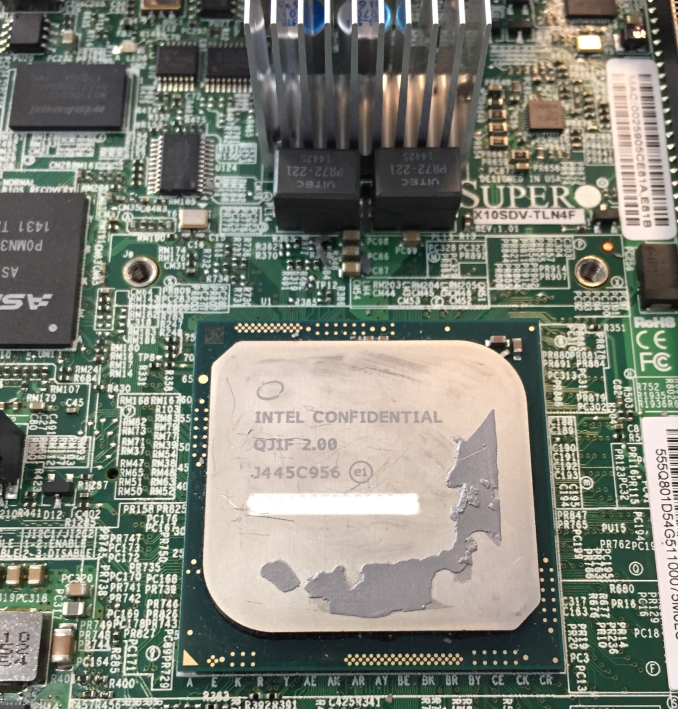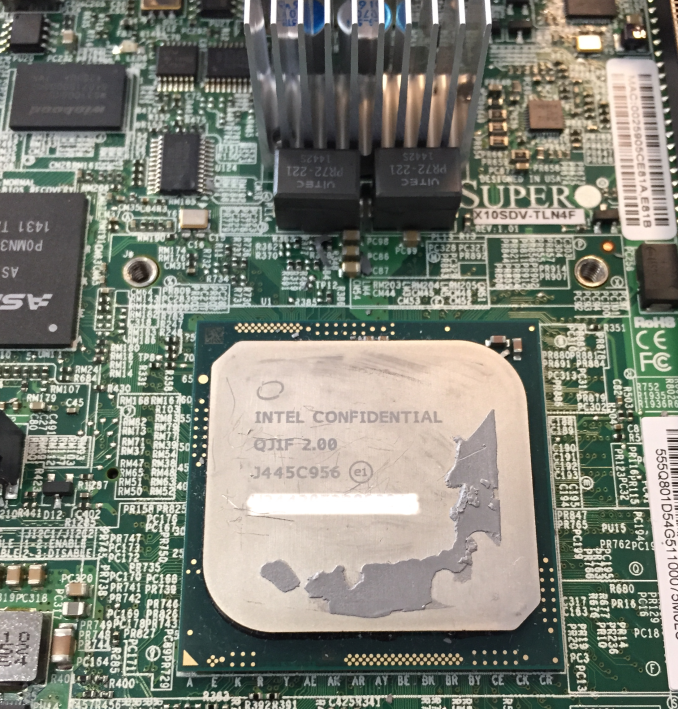The Intel Xeon D Review: Performance Per Watt Server SoC Champion?
by Johan De Gelas on June 23, 2015 8:35 AM EST- Posted in
- CPUs
- Intel
- Xeon-D
- Broadwell-DE

The days that Intel neglected the low end of the server market are over. The most affordable Xeon used to be the Xeon E3: a desktop CPU with a few server features enabled and with a lot of potential limitations unless you could afford the E5 Xeons. The gap, both in performance and price, between Xeon E3 and E5 is huge. For example - a Xeon E5 can address up to 768 GB and the Xeon E3 up to 32 GB. A Xeon E5 server could contain up to 36 cores, whereas Xeon E3 was limited to a paltry four. And the list is long: most RAS features, virtualization features were missing from the E3, along with a much smaller L3-cache. On those terms, the Xeon E3 simply did not feel very "pro".
Luckily, the customers in the ever expanding hyperscale market (Facebook, Amazon, Google, Rackspace and so on) need Xeons at a very large scale and have been demanding a better chip than the Xeon E3. Just a few months ago, the wait was over: Xeon D fills the gap between the Xeon E3 and the Xeon E5. Combining the most advanced 14 nm Broadwell cores, a dual 10 gigabit interface, a PCIe 3.0 root with 24 lanes, USB and SATA controllers in one integrated SoC, the Xeon D has excellent specs on paper for everyone who does not need the core count of the Xeon E5 servers, but who simply needs 'more' than the Xeon E3.
Many news editors could not resist calling the Xeon D a response to the ARM server threat. After all, ARM has repeated more than once that the ambition is to be competitive in the scale-out server market. The term "micro server" is hard to find on the power point slides these days; the "scale-out" market is a lot cooler, larger and more profitable. But the comments of the Facebook engineers can quickly brings us back to reality:
"Introducing "Yosemite": the first open source modular chassis for high-powered microservers"
"We started experimenting with SoCs about two years ago. At that time, the SoC products on the market were mostly lightweight, focusing on small cores and low power. Most of them were less than 30W. Our first approach was to pack up to 36 SoCs into a 2U enclosure, which could become up to 540 SoCs per rack. But that solution didn't work well because the single-thread performance was too low, resulting in higher latency for our web platform. Based on that experiment, we set our sights on higher-power processors while maintaining the modular SoC approach."
It is pretty simple: the whole "low power simple core" philosophy did not work very well in the real scale out (or "high powered micro server") market. And the reality is that the current SoCs with an ARM ISA do not deliver the necessary per core performance: they are still micro server SoCs, at best competing with the Atom C2750. So currently, there is no ARM SoC competition in the scale out market until something better hits the market for these big players.
Two questions remain: how much better is the 2 GHz Xeon D compared to the >3GHz Xeon E3? And is it an interesting alternative to those that do not need the high end Xeon E5?











90 Comments
View All Comments
extide - Wednesday, June 24, 2015 - link
So, I was thinking last night, that this chip is THE PERFECT enthusiast chip! All Intel needs to do is release an unlocked and socketed version (although that would be complex because there is currently no platform for it ...) although if we could get at least an unlocked version on an enthusiast style board it would be awesome.Think about it:
8 Broadwell cores -- Great!
12MB L3 -- Great!
24 Lanes PCIe 3.0 -- More than 16 or even skylakes rumored 20, pretty good. You could do things like 16x + 8x, or 8x + 8x + 4x + 4x (the two 4x being m.2 ssd's) which would support CF or SLI quite well and some fast ssd's.
2ch DDR4 -- plenty for gaming and most enthusiast applications
Dual 10GbE -- Just added Gravvy here, but would def help adoption of 10g in the enthusiast realm.
COME ON INTEL!!
extide - Wednesday, June 24, 2015 - link
Also, I forgot to add:This would be a great intermediate between the current regular consumer stuff (LGA 115x) and HPDE (LGA 2011x) -- A lot of people really see the LGA 2011 platform as overkill, even for enthusiasts, and it gets so expensive, with quad channel ddr4 and all that. This chip just seems to make so much sense. Now if intel priced it no more than the $500 mark, that would be awesome. Imagine, if AMD was more competitive, we might actually have that5 scenario.... Hopefully Zen is just great!
Namisecond - Saturday, June 27, 2015 - link
Intel's tray price for this chip is listed at $199 for the 4-core and $581 for the 8-core. The price for the CPU+motherboard is almost $1K for the 8 core. which indicates the problem is not in the price of the chip itself.If you want cheap and low power consumption, I'd direct you to the S1150 platform with Xeon E3 V3 "L" series (13-45W) processors.
spikebike - Wednesday, June 24, 2015 - link
For a home machine, small server, workstation, or similar the Xeon D 1520 looks even better. Faster clock, 1/3rd the price, same maximum ram, ecc, etc. Sure it's got 4 cores/8threads instead of more, but for many use cases that's not a big limitation. In quite a few cases spending the $400 different on RAM or SSDs will make a bigger difference.hifiaudio2 - Thursday, June 25, 2015 - link
Where can you get a 1520? Google searching is not finding anything for sale...hifiaudio2 - Thursday, June 25, 2015 - link
If I cannot find the 1520 for sale, what is the best bang for the buck i3 and MB combo (want to use ECC ram as well) for a Media server/transcode/nas? Low TDP, etc..jaziniho - Thursday, June 25, 2015 - link
Any word on whether HP plan to make a Moonshot cartridge featuring Xeon D? the 45W TDP seems to match up with some of the previous chips they have used.jeffsci - Monday, June 29, 2015 - link
Why do the results use a variety of OSS compilers? For an Intel Xeon processor, the Intel compilers are the most reliable. Is Open64 actively developed for Intel processors? And switching from GCC 4.8 to 4.9 with different flags...how is this even remotely scientific?needforsuv - Saturday, July 11, 2015 - link
so they just done to the 'regular' 4/8 i7/e3 what they did to the C2D in making the C2Q but more sophisticated I like it now wheres that lga 115x 8 coretabascosauz - Sunday, July 19, 2015 - link
I hope that Mr. de Gelas will continue to learn and improve as a writer, because the grammar in this article is, in numerous places, rather iffy and AT has traditionally excelled in delivering detailed, grammatically correct content.